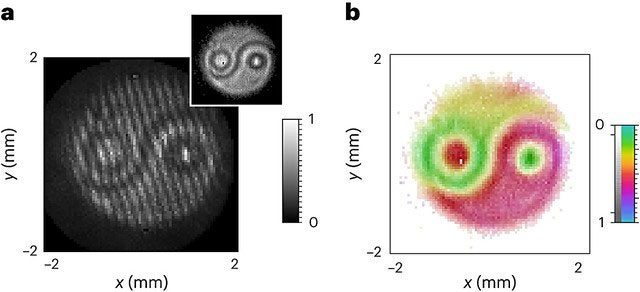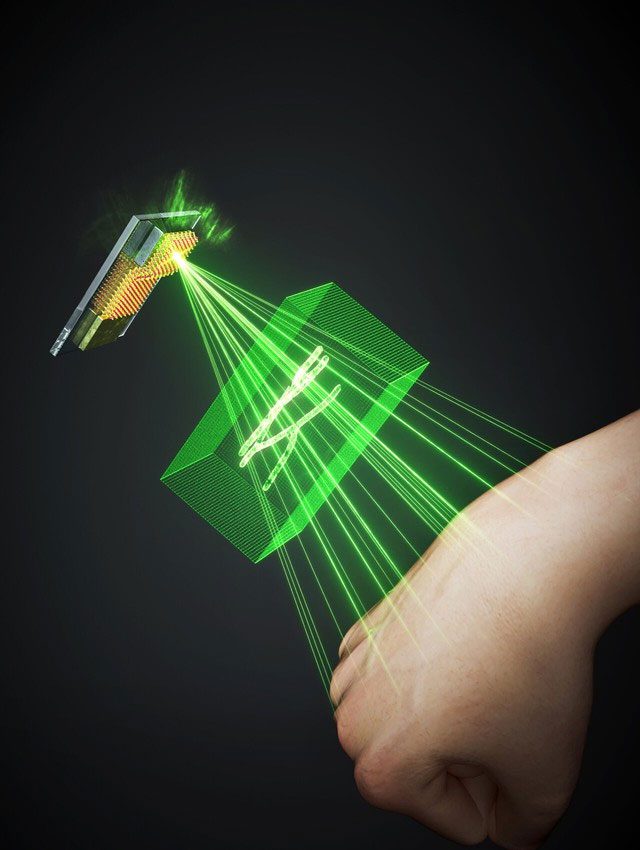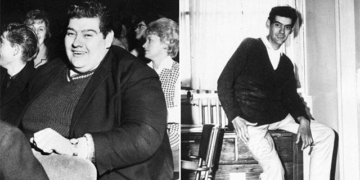The collaboration between scientists from the University of Ottawa and Sapienza University has successfully recorded the dance of two entangled quantum photons in real time for the first time.
Specifically, the team demonstrated a new technique that allows them to reconstruct the wave function image of two entangled light particles (photons).
To illustrate, if we compare a pair of photons to a pair of shoes, the phenomenon of “quantum entanglement” can be likened to randomly selecting one shoe; once its identity is determined, a person instantly knows the nature of the other shoe, regardless of its location. However, the intriguing aspect is the uncertainty of identifying the shoe’s nature, which remains ambiguous until the moment of measurement.

Reconstructing the image of the pair of entangled photons – (Image: Nature).
The wave function, a fundamental principle of quantum mechanics, provides a specific view of a particle’s quantum state. In the shoe example, the “wave function” of the shoes would include information such as whether it is a left or right shoe, the shoe size, color, etc.
More precisely, the wave function allows scientists to predict the outcomes of quantum measurements of particles, such as position or velocity.
This predictive ability is invaluable, especially as the field of quantum technology advances rapidly. When we know the generated quantum state or the properties of a particle, we can experiment with quantum computers. Furthermore, the quantum state of particles in a quantum computer is highly complex, involving many entities with their own quantum states.
Determining the wave function of a quantum system is challenging – this process is also referred to as quantum state tomography, or simply quantum tomography. The basic method requires a large amount of measurements, with the number increasing proportionally to the complexity of the system.
However, previous research has shown that to capture the quantum state of two photons in a complex system, a research group could take several hours or even days. Moreover, the quality of the measurement results is very sensitive to noise signals and heavily depends on the complexity of the system.
One can compare the quantum tomography referencing method to observing the shadow cast on a wall by an object. Based on what is observed, scientists can estimate the state of the entire photon. For instance, from a 2D image, one can infer the 3D shape of the object.
In classical optics, there is another way to create a 3D image. Known as digital holography, this method relies on a single image generated from the light scattered after illuminating an object.

As technology advances, the ability to create 3D images becomes more sophisticated – (Image: Internet).
By applying and simultaneously extending this method to a pair of photons, the research team led by Ebrahim Karimi – co-director of the Ottawa Quantum Technology Nexus (NexQT) and an associate professor at the Faculty of Science – aimed to capture the phenomenon of quantum entanglement.
Reconstructing the quantum state of two photons requires scientists to overlay them with another quantum state that has been thoroughly studied, then analyze the positions of the two photons. The result of measuring the positions of the two photons is termed “coincidence image.” These photons can originate from the light source used in the experiment or an unknown source, as quantum mechanics asserts that the source of the photons cannot be identified.
The process of measuring photons generates interference patterns from which scientists calculate the wave function. The success of the experiment is attributed to a camera system capable of capturing pixels at nanosecond resolution.
Professor Alessio D’Errico from the University of Ottawa, one of the many authors of the new study, emphasized the advantages of this innovative research method. “This approach is much faster than previous methods, taking only a few minutes or seconds compared to the days it would have taken before. Most importantly, the measurement time is unaffected by the complexity of the system,” the professor stated.
This new research not only holds significance for the academic community but also has the potential to accelerate the pace of quantum technology research, simplifying the ability to determine the nature of quantum states, quantum communication systems, and even aiding in the development of new quantum imaging methods.
The research has been published in the journal Nature Photonics.


















































